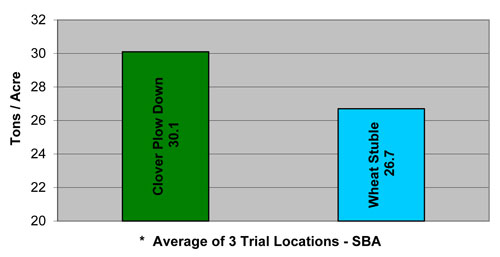Still time to frost-seed clover in wheat
Sugarbeets and other crops can benefit from clover being in the rotation. The late spring in 2014 will extend the frost-seeding window.
Clover cover crops incorporated in field rotations can improve sugarbeet yields and reduce nitrogen inputs. Growers are highly encouraged to establish frost-seeded clover into their wheat this spring as a long-term approach for improving soil quality. It is a relatively easy and cost effective way to improve the following sugarbeet crop. Frost seeding red clover can be successful even in high-yielding wheat with no detrimental impact on wheat yields.
Red clover is Michigan’s most common cover crop. It is normally frost seeded into wheat in March. Michigan mammoth and June clover (also known as medium red clover) have been shown to perform better than other red clovers frost seeded into well fertilized wheat. A seeding rate between 10-12 pounds per acre has performed very well and can be applied with dry fertilizer if thoroughly blended and applied evenly. However, many clover growers prefer to apply clover with a small spreader and a utility vehicle which allows them to spread seed on soft soils. This method usually results in the best stands since the clover seed is spread while there are still freezing and thawing cycles that incorporate the seed into the soil.
Multiple benefits are derived from clover cover crops such as nitrogen production, reduced diseases and improved beet yields. Clover is a proven soil builder and can supply 40-60 pounds of nitrogen to the following crop. Grower-applied nitrogen rates should be reduced because excess nitrogen will reduce beet quality. In the past couple years, Sugarbeet Advancement trials have demonstrated a dip in sugarbeet quality following clover cover crops where the growers did not reduce their nitrogen rate.
Recent field trials conducted by Michigan State University Extension/Sugarbeet Advancement have shown yield improvements ranging from 1 to 3 tons/acre which is similar to improvements with oilseed radish in fields with known sugarbeet cyst nematodes (Chart 1). The yield improvement depends on the growth/density of the clover as well as disease and nematode issues in the field. Fields trials have shown a significant reduction in Rhizoctonia root rot on sugarbeets. Research conducted at the MSU Bean and Beet Research Farm has shown positive crop yield responses lasting more than one year from clover.
Clover should be incorporated into the soil late in the fall when soil temperatures are below 50 degrees either by mold board or chisel plowing. This will maximize growth of the clover and retain the most nitrogen for the following crop. Incorporating clover too early in the fall will allow for increased microbial breakdown and potential loss of the nitrogen. Many growers will apply a glyphosate application prior to fall tillage to improve control if chisel plowing. Stinger herbicide can also be used to control volunteer clover during the beet growing season.



 Print
Print Email
Email





